

Max Davies
2026 Skoda Octavia: Mild-hybrid power confirmed for mid-size sedan, wagon
6 Days Ago
A wagon has returned to the Subaru WRX line, though the new Sportswagon is known as a Levorg elsewhere and has a different feel to the sedan.



Quickly see how this car stacks up against its competition. Select any benchmark to see more details.
Where expert car reviews meet expert car buying – CarExpert gives you trusted advice, personalised service and real savings on your next new car.
Meet the new Subaru Levorg – er, sorry, WRX Sportswagon.
Perhaps because after six years the average person still didn’t know what a Levorg was, Subaru Australia has wisely decided to call the second-generation model a WRX.
The Levorg name is therefore consigned to the bin in Australia. It first entered the picture in 2016 as a slightly smaller replacement for the Liberty wagon, axed in 2014.
The WRX is, of course, a name with considerably more name recognition with the average punter, although at least one person asked me, “Oh, do they still make WRXs?”. Ouch.

Once a fearsome sport sedan and wagon, the WRX’s position atop the small performance vehicle pecking order has been eroded by ever more powerful front-wheel drive hot hatches.
They mightn’t boast all-paw traction, but the likes of the Volkswagen Golf GTI, Ford Focus ST and Hyundai i30 N offer similarly heady performance.
Subaru has declined to bring less powerful versions of the Sportswagon here, only offering a full-fat turbocharged 2.4-litre.
The new WRX Sportswagon is actually sized quite closely to perhaps the best-looking Liberty wagon ever made, the fourth-generation model launched here in 2004. Its 2670mm wheelbase is identical, while length is up only 35mm (4755mm) and width is up by 65mm (1795mm).

What a pity, then, the WRX lacks the graceful form of its ancestor. While it avoids the goofy black plastic wheel arch extensions of its sedan counterpart – odd, given these would seem more appropriate for a wagon – it has a rather lumpy design.
It’s as though the designers didn’t know whether to make it look like a hatch or like a wagon. Its rear overhang appears almost too short, which makes the slightly long front overhang appear out of balance. The headlights appear tiny as well, at least to my eyes.
The old Levorg wasn’t a beauty queen, but it was more attractive than this.

The Subaru WRX Sportswagon range starts at $49,990 before on-road costs, or $1000 more than a base auto sedan. No price-leader manual option is available.
The mid-range GT is the wagon equivalent to the RS sedan and is priced at $55,490 before on-roads, while the flagship tS rings up at $57,990 before on-roads.
Based on a Sydney postcode, you’re looking at a drive-away price of $61,023 for our GT tester.

A Volkswagen Golf R wagon is a whopping $11,000 more than even the flagship WRX Sportswagon, while no Golf GTI wagon exists.
A Skoda Octavia RS wagon is $57,490 drive-away, though it lacks the WRX’s all-wheel drive.
Beyond that, there’s nothing else with a wagon body and similar performance aspirations as the WRX Sportswagon at this price point.

Buy your new car without the stress. It's fast, simple and completely free.

Great service from Travis and team, second time I have used this business would not hesitate to recommend them to anyone
Craig C.
Purchased a Ford Ranger in Sunshine Coast, QLD
CarExpert helped Craig save thousands on his Ford Ranger, now let us save you on your next new car.
Find a dealWith a dashboard dominated by a large, portrait-oriented touchscreen, the WRX’s interior looks slick and modern.
There are no felt-lined bottle holders in the doors or Ultrasuede seat upholstery like the tS, but otherwise the GT’s cabin is identical to the flagship wagon.
The main menu of the touchscreen features large, colourful buttons, though some functions are buried in sub-menus.
Subaru has kept a handful of physical buttons, for example those for adjusting the temperature, but has moved almost everything else to the touchscreen. That means some functions, like turning on the heated seats, take an extra button push to perform. At least the car remembers your heated seat settings upon start up.
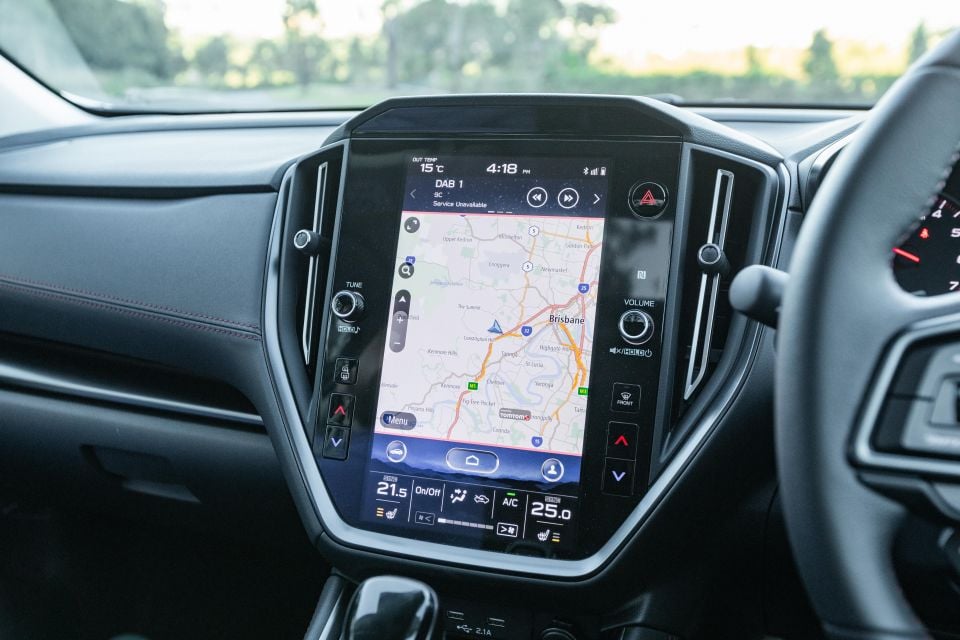

The satellite navigation has a little label on it saying it’s Powered by TomTom, but that’s not really anything to brag about. The graphics look aftermarket, and they don’t have the contemporary look of, say, a Golf R or i30 N.
There’s a chunky leather-wrapped wheel and comfortable leather-accented seats. Soft, subtle ambient lighting emanates from the dash, doors and cupholders. There’s a standard sunroof in the GT, but it’s only a single-pane affair.
Material quality is generally good. There’s exceptionally soft, leather-look material on the sides of the centre console, while soft-touch plastics and leatherette trim can be found on all four doors and the passenger-side of the dash top is finished in soft-touch plastic.
In terms of storage, there are bottle holders that can fit 1L bottles, as well as two decent-sized cupholders. There’s a centre-console bin, but a CD player takes up too much of the space.

Step into the back and there’s enough headroom for someone my height (180cm), and I can comfortably sit behind my own driving position. There’s a raised driveline tunnel that constricts the centre-seat occupant, though I could sit in the middle without my head touching the roof.
Two USB-A ports can be found at the base of the centre console below the air vents, while there’s a fold-down centre armrest with cupholders plus bottle holders that can fit a 1L bottle.
Dropping the second row is easy. You either pull a lever in the cargo bay, or you pull a little knob on the seat itself. Once dropped, there’s a completely flat load bay.

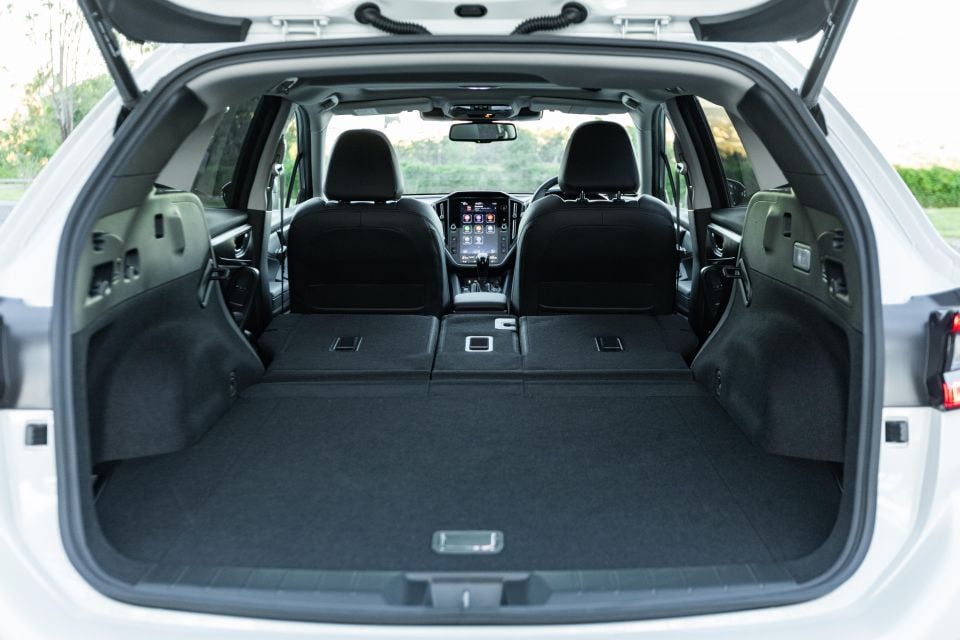
The backrest folds 40/20/40, and there’s a trio of top-tether anchor points for child seats along with outboard ISOFIX points.
Boot space is a claimed 492 litres with the rear seats in place, expanding to 1430 litres with them folded. Skoda claims 640 litres and 1700 litres for its Octavia RS wagon, in contrast.
Lift up the boot floor panel and you’ll find a temporary spare, while there are two recessed cubbies on either side of the panel.

The WRX Sportswagon, like the sedan, is powered by a 2.4-litre turbocharged flat-four engine producing 202kW of power at 5600rpm and 350Nm of torque between 2000 and 5200rpm.
Power is sent to all four wheels through an all-wheel drive system with active torque vectoring. It defaults to a 45/55 front/rear torque split.
Only a continuously-variable transmission is available in the wagon, whereas the sedan can be had with a six-speed manual – if you don’t mind missing out on a bunch of active safety and driver assist features, that is.

The WRX GT has a claimed 6.1-second 0-100km/h time, 0.6 seconds quicker than the Octavia RS. The Czech wagon has less power (180kW) but more torque (370Nm), however it misses out on all-wheel drive.
Subaru claims a combined cycle fuel consumption of 8.5L/100km, and in a rarity we actually managed to beat that by 0.3L/100km on a loop consisting of inner-city, suburban and highway driving.
Over a course of a week with the WRX, albeit with a heavy skew towards urban driving, this increased to 11.3L/100km – just 0.1L/100km off the official urban fuel consumption claim.

Precious few performance cars have used a continuously-variable transmission in automotive history. There’s a reason for that, but Subaru has nevertheless continued to put a CVT in its WRX while most small performance cars long ago moved to dual-clutch automatics. Even the Europeans, who invented the CVT, have largely moved away from it even in more mainstream fare.
A CVT has its use cases, but a WRX doesn’t seem like the kind of vehicle in which it should be used. And yet, the CVT isn’t the weakest link in the WRX’s dynamic package.
Our own resident WRC driver Chris Atkinson observed the steering in the WRX sedan seems to completely isolate you from the road. Well, the wagon’s tiller is even more disconnected.

It’s overly light and lacking in feel, and no drive mode adjustment can bring the Sportswagon to the same level as the sedan, let alone similarly powerful hot hatches and wagons.
It’s no better in the flagship tS, where you can choose between three steering modes: disconcertingly wobbly (Comfort), overly light and feel-free (Normal) and tolerable (Sport).
The light weighting and complete lack of road feel is noticeable not only on a winding mountain road, but also in low-speed manoeuvres. Start to reverse in a parking spot and there’s no progression to the steering, and you end up banging into full lock.
The WRX Sportswagon is called a Levorg everywhere else, and that means there’s quite a difference in feel between it and the sedan. The sedan already feels a bit too subdued for something with a WRX badge, and the wagon goes further down this path.
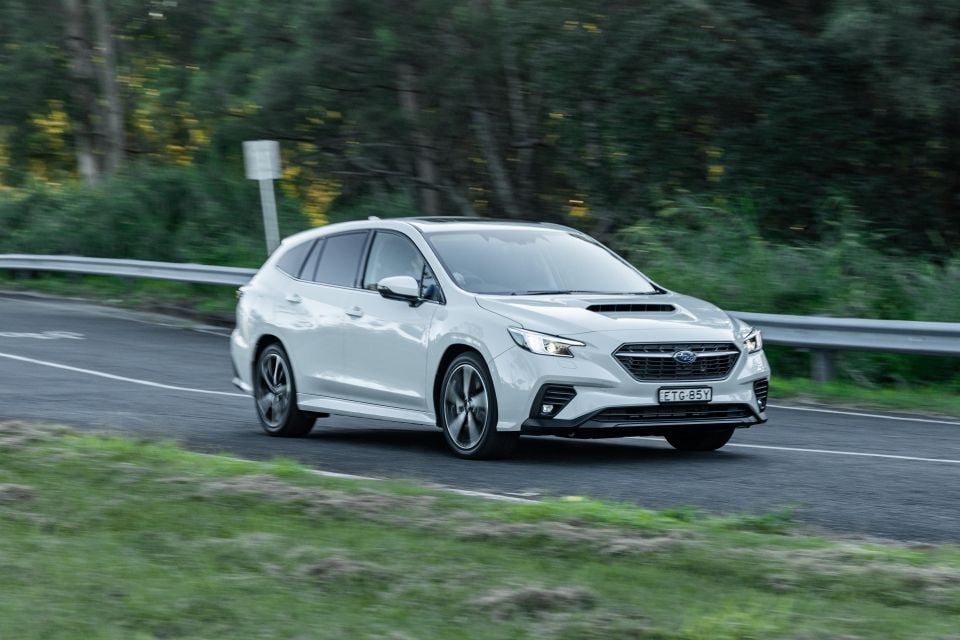
Where expert car reviews meet expert car buying – CarExpert gives you trusted advice, personalised service and real savings on your next new car.
A Golf R can be almost clinical in its all-round competence, and yet it has this alacrity in feel that makes it feel more impressive than this WRX. While there’s plenty of power and torque on paper, the WRX never feels like a truly hot wagon. It’s missing that certain special something.
That could be in part due to the lack of a sporty sound. The WRX lacks the exhaust crackles and rorty engine note of any Hyundai with an N badge, though there’s the familiar Boxer engine thrum on start-up.
It alternates between being generally too quiet (regular driving) and too noisy (highway driving), with the cabin getting boomy at highway speeds as wind noise penetrates the cabin. The engine sometimes has a strained note to it, too.
The WRX Sportswagon has the balanced chassis and terrific grip you would expect from something with this nameplate, and if it wasn’t for its wet-noodle steering it would be a genuinely fun car to take to a winding road.

The CVT, though maligned by enthusiasts, does a decent approximation of a torque-converter automatic when you shift it into Sport Sharp mode. It shifts between eight artificial steps, displayed in the instrument cluster, though like the Sport mode in a DCT or torque converter it will often hold onto a “gear” for too long.
Fortunately, there are paddle shifters that allow you to shift up or down, and Sport Sharp mode won’t override your shifts as the CVT is wont to do in Intelligent and Sport modes. Sport Sharp also gives you sharper throttle response.
Even in Intelligent and Sport modes, the CVT avoids the worst of the slurring and rev flare this transmission type is known for. It’s pleasant enough, though a torque-converter or dual-clutch would still be preferable.
The extra adjustability of the tS’s adaptive suspension is nice, but the GT’s passive setup is still quite good. Though it’s firm, it filters out bumps nicely – certainly more so than an RS sedan I also drove, where the ride could become harsh and jiggly. It’s overall quite comfortable, something not often said about the old Levorg.

The suite of driver assist and active safety features prove a cavalcade of flashing lights and beeps. Look slightly away to your side? Bing, a warning flashes telling you to keep your eyes ahead as an orange light flashes. Lane markings fade away? Bing, a warning flashes saying the lane assist system is off, and an orange light flashes.
The warnings largely make sense, though they’re louder and, well, flashier than in other cars. However, on more than one occasion I had the adaptive cruise control and lane centring on, I was within the lane markings and following the speed limit and I had to endure a cacophony of repeated beeps and green flashing lights.
It turns out that, by default, the adaptive cruise control will sound a beep when it detects a vehicle in front of you, even if you have a safe distance. Fortunately, this feature can be turned off.
Bizarre beeping aside, the adaptive cruise control and lane centring work exceptionally well. The lane centring only works in conjunction with the adaptive cruise, and can work at speeds between 0 and 145km/h.

The lane-keep assist function, which works at speeds up to 60km/h, is unobtrusive. There’s also an emergency lane-keep assist function for speeds above 60km/h, though fortunately we didn’t have to experience this.
The automatic stop/start has one of the smoother calibrations out there, and the presence of auto hold is much appreciated. Less appreciated is the fact you have to use the touchscreen to turn it on every single time you start the car – that’s two presses of the touchscreen instead of a single button push like in most cars.
Perhaps my favourite feature is the steering-responsive lighting up front, with the headlight beam shifting in the direction in which you move the steering wheel. It’s hardly new technology – Citroen was offering directional headlights in its DS as early as the 1960s – but it’s not a hugely common feature today.
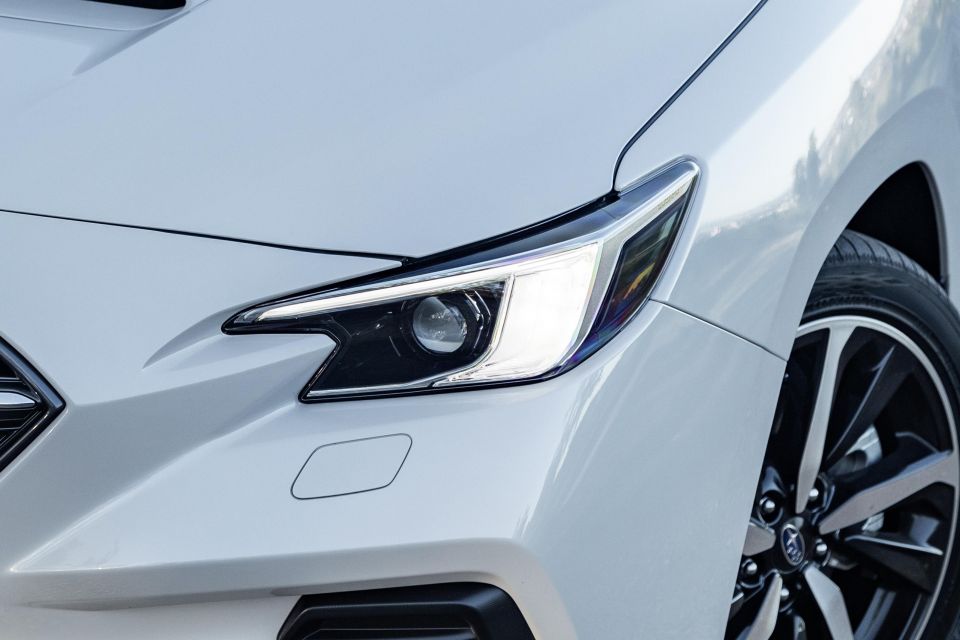



The WRX GT includes the following standard equipment:
There are some minor specification differences between it and the corresponding RS auto sedan, which swaps leather upholstery for Ultrasuede and features a 10-speaker Harman Kardon sound system.
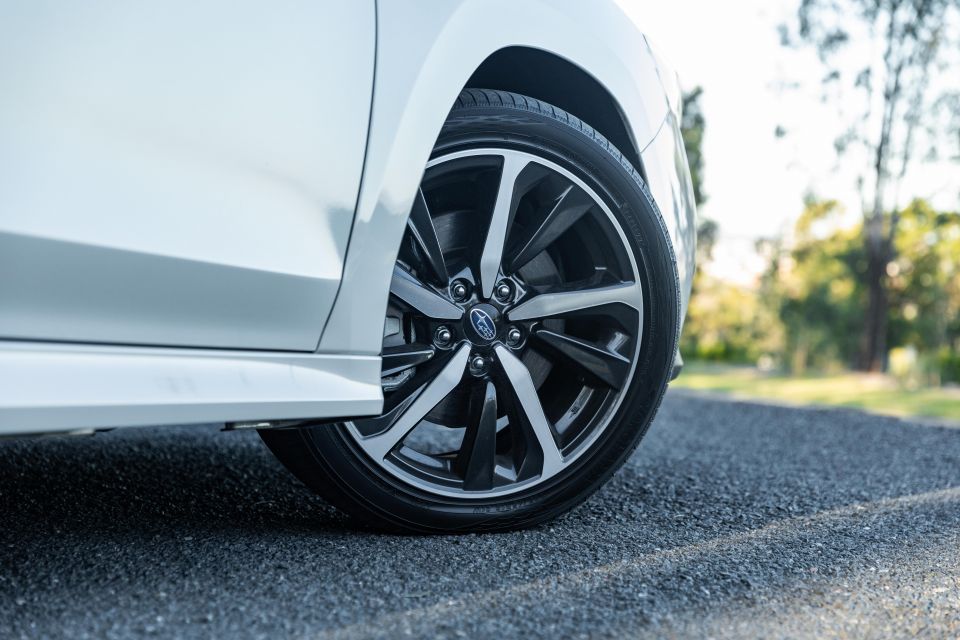

The GT’s equipment is in addition to kit found in the base Sportswagon, which includes:
Bizarrely, there are no front parking sensors on any WRX. There’s no surround-view camera either, though there are side camera views to help you guide the car into a parking spot.
You can step up to the tS, which adds electronically-controlled dampers, Ultrasuede upholstery, and selectable Comfort, Normal, Sport, Sport+ and Individual drive modes.
The Octavia RS requires a $6100 option package to be selected in order for you to get heated front and rear seats, though this package also includes some worthwhile features like a head-up display.
The Skoda otherwise largely matches the Subaru while also offering as standard niceties like a digital instrument cluster and more attractive 19-inch alloy wheels.
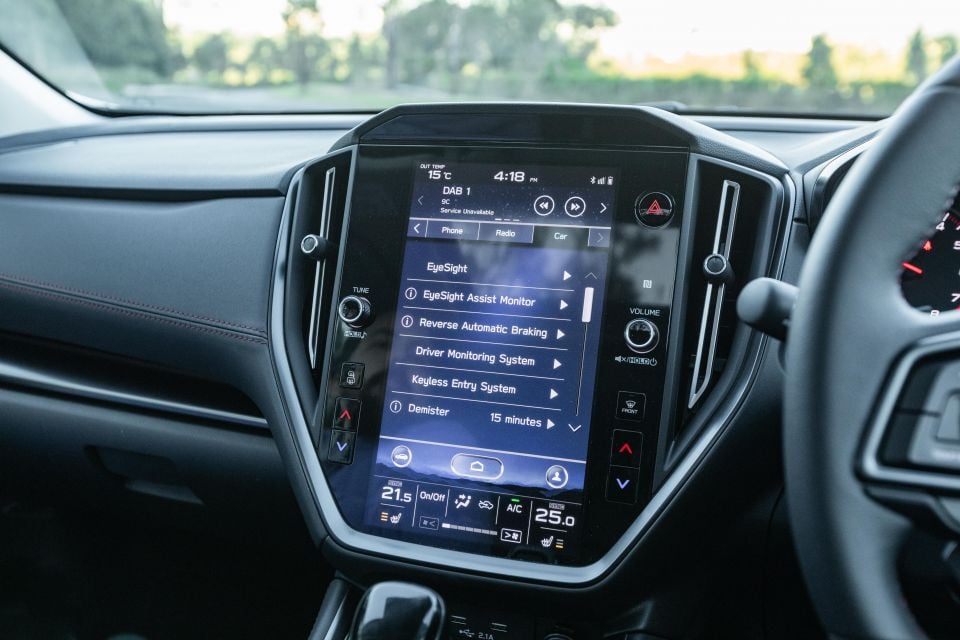
The Subaru WRX has yet to be tested by ANCAP.
All Sportswagon models come standard with a full complement of active and passive safety and driver assist features. These include:

The WRX is backed by a five-year, unlimited-kilometre warranty.
Subaru offers five years of capped price servicing, with intervals of 12 months or 15,000km. The first five services are capped at $355.23, $481.65, $429.39, $736.22 and $363.25, or a total of $2365.74 over five years.
An Octavia RS can be bought with a five-year service pack, which costs $2000.

A small/medium wagon is going to be a niche player in Australia in 2022, so Subaru has shrewdly opted to bring the Levorg here only in its most powerful guise and has applied the vastly better-known WRX nameplate.
With even non-performance wagons having become unlikely enthusiast choices as buyers move en masse to SUVs, the WRX Sportswagon is unlikely to be cross-shopped by your typical family buyers.
While the hot hatch market in Australia is thriving, the WRX is still an iconic nameplate that commands respect. But it also carries the weight of expectations, so it’s a pity this smallish hot wagon, a vehicle so clearly aimed at enthusiasts, doesn’t sufficiently cater to that audience.
There’s no manual transmission available, while the only auto is a CVT. In a section of the market dominated by dual-clutches, that’s a handicap with enthusiast buyers.

But the CVT, which is generally a decent thing, isn’t what lets the WRX Sportswagon down. It’s the vague steering, which proves the most disappointing aspect of an otherwise commendable package.
That puts the WRX Sportswagon in an unenviable position. The rebadged Levorg finally has a well-known nameplate that could raise its profile here, but as a WRX it doesn’t feel as visceral as it should.
If you have a family and refuse to consider a mid-sized SUV, the Levorg’s comfortable, practical and well-appointed cabin makes it a surprisingly sensible choice.
It isn’t intimidating to drive, and if your partner doesn’t mind sitting lower than in a Forester it could prove a comfortable, capable family car turned weekend warrior. The tS’ adaptive dampers are worth the extra spend, but stepping down to the base model is an even smarter move – particularly considering it has the full complement of safety equipment you want in a family car.
Now, if Subaru retune the steering, we could recommend it as an enthusiast choice, too.

MORE: Everything Subaru WRX
Where expert car reviews meet expert car buying – CarExpert gives you trusted advice, personalised service and real savings on your next new car.
William Stopford is an automotive journalist with a passion for mainstream cars, automotive history and overseas auto markets.


Max Davies
6 Days Ago


Ben Zachariah
8 Days Ago


William Stopford
1 Month Ago


Damion Smy
2 Months Ago


Max Davies
2 Months Ago
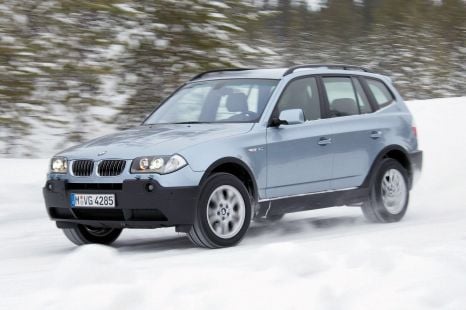

Marton Pettendy
3 Months Ago